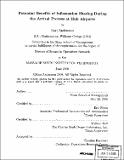Potential benefits of information sharing during the arrival process at hub airports
Author(s)
Andersson, Kari
DownloadFull printable version (5.856Mb)
Other Contributors
Massachusetts Institute of Technology. Operations Research Center.
Advisor
Eric Feron and William Hall.
Terms of use
Metadata
Show full item recordAbstract
This thesis explores the benefits of increasing communication and collaboration between airlines and air traffic controllers during the arrival process at hub airports. In particular, this study estimates operational improvements, measured in passenger minutes of delay saved, from providing airlines with more accurate landing time estimates and from allowing airlines to influence the sequence of incoming traffic. To estimate these potential benefits, the Airline Sequencing model was developed to simulate airline decisions regarding ground operations. The model has been calibrated and validated to reflect airline decision making. Scenario analyses were conducted using the model to estimate the delay savings that an airline could realize through the use of more accurate landing time estimates although the potential ability to influence the sequence of arriving traffic. The current results indicate that. increased communication and collaboration could significantly decrease delays. Over a time horizon of 3.25 hours, a decrease in the standard deviation in landing time estimate errors of two minutes could prevent between 500 and 2000 passenger minutes of delay. Allowing an airline to shift each arriving aircraft's landing time up to 5 minutes can save between 4000 and 7000 passenger minutes of delay over a time period of 3.25 hours. The potential savings depend on the delay conditions of the time horizon considered in the model. These results indicate that the potential reduction in delay could be significant. Further investigation into the feasibility of the communication and collaboration suggested in this thesis is warranted.
Description
Thesis (S.M.)--Massachusetts Institute of Technology, Sloan School of Management, Operations Research Center, 2000. Includes bibliographical references (p. 81-82).
Date issued
2000Department
Massachusetts Institute of Technology. Operations Research Center; Sloan School of ManagementPublisher
Massachusetts Institute of Technology
Keywords
Operations Research Center.